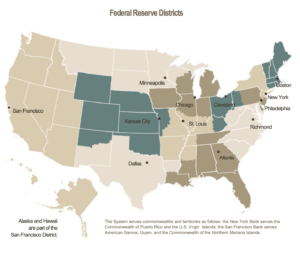Beef prices are projected to continue increasing as U.S. beef production declines with no signs of a cattle herd rebuild. Additionally, cheap beef may soon become further out of reach…
Federal Reserve: Observations on the Ag Economy- May 2023
On Wednesday, the Federal Reserve Board released its May 2023 Beige Book update, a summary of commentary on current economic conditions by Federal Reserve District. The report included several observations pertaining to the U.S. agricultural economy.

* Sixth District- Atlanta– “Agricultural conditions softened since the previous report. Demand for cotton remained weak, leading many farmers to plant less cotton than last year. Cattle demand was strong. Producers of poultry meat continued to struggle as limits on exports resulting from Avian Flu concerns have led to over-supply domestically. Domestic egg demand remained high. Dairy consumption declined. Demand for citrus remained strong amid lower production.”
* Seventh District- Chicago– “Expectations for Seventh District farm incomes in 2023 fell some as prices for key products moved lower.
Corn and soybean prices decreased, as rapid fieldwork and planting progress heightened expectations for a large harvest. Soft red wheat prices remained weak, but hard wheat prices rose due to drought affecting much of the U.S. wheat crop and uncertainty surrounding another extension of the agreement allowing exports out of Ukraine.
“There were lower prices for eggs and dairy products, especially cheese. Hog prices increased from a low level and cattle prices moved higher. In light of higher interest rates, contacts expected farmers to conserve working capital to minimize the need to take out farm operating loans.
"On average, #farm loan #interestrates were 40 basis points and 300 basis points higher than last quarter and a year ago, respectively," https://t.co/8uQGKp7WXP @KansasCityFed pic.twitter.com/3kSFvWjbWB
— FarmPolicy (@FarmPolicy) May 30, 2023
“There were reports of slower farm machinery sales but also shortages of some types of equipment. Prices for farmland were higher again as demand remained solid and inventories of farms for sale were limited.”
"The value of nonirrigated farmland was about 10% higher than a year ago across all reporting regions.
— FarmPolicy (@FarmPolicy) May 30, 2023
"The pace of growth in #agricultural real estate values has slowed from rapid increases in 2021 and 2022, but remained resilient," https://t.co/8uQGKp7WXP @KansasCityFed pic.twitter.com/rKPTTyLgRR
* Eighth District- St. Louis– “Overall conditions have remained unchanged, but the outlook has weakened slightly since our previous report. Most agriculture contacts surveyed reported that their costs, including labor, have increased, which has contributed to the slightly worsening outlook. The percentage of row crops planted has increased as expected since the previous reporting period and is up slightly from this time in 2022. The progress of acres planted is mixed across the District: Some states, such as Missouri and Illinois, have improved strongly over last year, and the other District states have fared slightly to materially worse.”
* Ninth District- Minneapolis– “District agricultural conditions were solid heading into planting season. About half of respondents to a survey of agricultural credit conditions reported that farm incomes increased in the first quarter from a year earlier.
Lenders noted improvements in liquidity and in the financial condition of producers, but they were concerned about commodity price volatility and rising interest rates.
“Heavy snow over the winter and persistent cold weather will significantly delay spring planting in some areas, contacts reported.”
* Tenth District- Kansas City– “Conditions in the Tenth District agricultural economy remained strong through early May but showed signs of moderating. Corn and soybean prices declined slightly since April and were moderately lower than a year ago. Prices moved down recently based on reports of ideal planting conditions throughout most states and early projections that production could hit record levels due to historically strong yields. Wheat prices increased slightly since April, but poor yields caused by drought could limit revenues, particularly in Kansas and Oklahoma. Profits among cattle producers continued to be pressured by high feed costs and drought that damaged pasture conditions throughout the region.”
"Similar to credit conditions, the pace of improvement in #farm income slowed in all participating Districts," https://t.co/8uQGKp7WXP @KansasCityFed pic.twitter.com/wTJzqV9VxR
— FarmPolicy (@FarmPolicy) May 30, 2023
* Eleventh District- Dallas– “Recent rainfall improved drought conditions in the eastern part of the district while severe drought persisted in much of the western part. Grain prices generally decreased over the reporting period, amid a positive outlook for U.S. crop production this year. Drought will hamper crop production in Texas, however, and, in particular, contacts expect a below average cotton crop this year. A bright spot for agricultural producers is on the livestock side, where cattle prices rose notably over the past six weeks and are significantly above last year’s prices, supported by tighter supplies and solid demand for beef.”
* Twelfth District- San Francisco– “Conditions in agriculture and resource-related sectors weakened slightly. Reports on exports were mixed as ocean freight costs eased somewhat, while the war in Ukraine continued to contribute to shipping disruptions. Contacts in California noted that wet weather conditions lowered yields for brassicas and berries. Rains also disrupted pollination for tree and vine crops, which is anticipated to reduce yields. Seafood stocks were reportedly stable in the Pacific Northwest. Contacts noted lower costs for transportation and irrigation water and higher costs for other inputs such as for packaging, fertilizer, and energy.”





